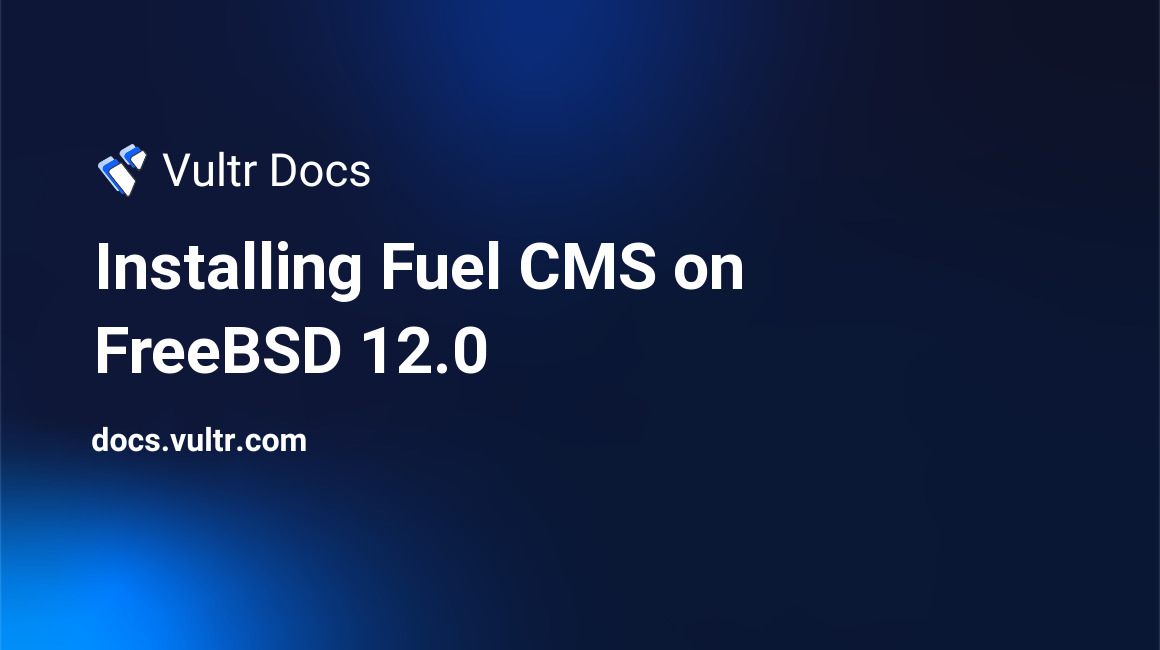Installing Fuel CMS on FreeBSD 12.0

Fuel CMS is a CodeIgniter based content management system. Its source code is hosted on GitHub. This guide will show you how to install Fuel CMS on a fresh FreeBSD 12.0 Vultr instance.
Requirements
- Nginx or Apache server with
.htaccess. This tutorial will use Nginx. - PHP version 5.4 or greater.
- A MySQL 5.0 (or newer) database if using the Fuel admin. Currently, it does not support other databases.
Before you begin
Check the FreeBSD version.
uname -ro
# FreeBSD 12.0-RELEASEEnsure that your FreeBSD system is up to date.
freebsd-update fetch install
pkg update && pkg upgrade -yInstall the necessary packages.
pkg install -y sudo vim unzip curl wget bash socat gitCreate a new user account with your preferred username. We will use johndoe.
adduser
# Username: johndoe
# Full name: John Doe
# Uid (Leave empty for default): <Enter>
# Login group [johndoe]: <Enter>
# Login group is johndoe. Invite johndoe into other groups? []: wheel
# Login class [default]: <Enter>
# Shell (sh csh tcsh nologin) [sh]: bash
# Home directory [/home/johndoe]: <Enter>
# Home directory permissions (Leave empty for default): <Enter>
# Use password-based authentication? [yes]: <Enter>
# Use an empty password? (yes/no) [no]: <Enter>
# Use a random password? (yes/no) [no]: <Enter>
# Enter password: your_secure_password
# Enter password again: your_secure_password
# Lock out the account after creation? [no]: <Enter>
# OK? (yes/no): yes
# Add another user? (yes/no): no
# Goodbye!Run the visudo command and uncomment the %wheel ALL=(ALL) ALL line, to allow members of the wheel group to execute any command.
visudo
# Uncomment by removing hash (#) sign
# %wheel ALL=(ALL) ALLNow, switch to your newly created user with su.
su - johndoeNOTE: Replace johndoe with your username.
Set up the timezone.
sudo tzsetupInstall PHP
Install PHP, as well as the necessary PHP extensions.
sudo pkg install -y php72 php72-mbstring php72-tokenizer php72-pdo php72-pdo_mysql php72-openssl php72-hash php72-json php72-phar php72-filter php72-zlib php72-dom php72-xml php72-xmlwriter php72-xmlreader php72-pecl-imagick php72-curl php72-session php72-ctype php72-iconv php72-gd php72-simplexml php72-zip php72-filter php72-tokenizer php72-calendar php72-fileinfo php72-intl php72-phar php72-soap php72-xmlrpc php72-opcache php72-mysqli php72-bcmath php72-gmpCheck the version.
php --version
# PHP 7.2.20 (cli) (built: Jul 25 2019 01:28:14) ( NTS )
# Copyright (c) 1997-2018 The PHP Group
# Zend Engine v3.2.0, Copyright (c) 1998-2018 Zend Technologies
# with Zend OPcache v7.2.20, Copyright (c) 1999-2018, by Zend TechnologiesSoft-link php.ini-production to php.ini.
sudo ln -s /usr/local/etc/php.ini-production /usr/local/etc/php.iniEnable and start PHP-FPM.
sudo sysrc php_fpm_enable=yes
sudo service php-fpm startInstall MariaDB
Install MariaDB.
sudo pkg install -y mariadb102-client mariadb102-serverCheck the version.
mysql --version
# mysql Ver 15.1 Distrib 10.2.25-MariaDB, for FreeBSD12.0 (amd64) using readline 5.1Start and enable MariaDB.
sudo sysrc mysql_enable="yes"
sudo service mysql-server startRun the mysql_secure_installation script to improve the security of your MariaDB installation.
sudo mysql_secure_installationLog into MariaDB as the root user.
mysql -u root -p
# Enter password:Create a new MariaDB database and user. Remember the credentials for this new user.
CREATE DATABASE dbname;
GRANT ALL ON dbname.* TO 'username' IDENTIFIED BY 'password';
FLUSH PRIVILEGES;
exit;NOTE: Replace dbname and username with appropriate names for your setup. Replace password with a strong password.
Install Nginx
Install Nginx.
sudo pkg install -y nginxCheck the version.
nginx -v
# nginx version: nginx/1.16.0Enable and start Nginx.
sudo sysrc nginx_enable=yes
sudo service nginx startRun sudo vim /usr/local/etc/nginx/fuel.conf and set up Nginx for Fuel CMS.
server {
listen 80;
listen [::]:80;
server_name example.com;
root /usr/local/www/fuel;
index index.php index.html;
location / {
try_files $uri $uri/ /index.php?q=$uri&$args;
}
location ~ \.php$ {
fastcgi_index index.php;
try_files $uri =404;
include fastcgi_params;
fastcgi_param SCRIPT_FILENAME $document_root$fastcgi_script_name;
fastcgi_pass 127.0.0.1:9000;
}
}Save the file and exit.
Now we need to include fuel.conf in the main nginx.conf file.
Run sudo vim /usr/local/etc/nginx/nginx.conf and add the following line to the http {} block.
include fuel.conf;Test the configuration.
sudo nginx -tReload Nginx.
sudo service nginx reloadInstall Fuel CMS
Create a document root directory.
sudo mkdir -p /usr/local/www/fuelChange ownership of the /usr/local/www/fuel directory to johndoe.
sudo chown -R johndoe:johndoe /usr/local/www/fuelNavigate to the document root folder.
cd /usr/local/www/fuelDownload the latest release of ExpressionEngine and unzip the files to a folder on your server.
wget https://github.com/daylightstudio/FUEL-CMS/archive/master.zip
unzip master.zip
rm master.zip
mv FUEL-CMS-master/* .
rm -rf FUEL-CMS-masterConfigure the fuel/application/config/database.php file with the proper database connection settings.
vim fuel/application/config/database.phpImport the fuel/install/fuel_schema.sql file into the newly created database.
mysql -u username -p password < fuel/install/fuel_schema.sqlNOTE: Replace username and password with your database credentials.
Change the $config['encryption_key'] on line 327 found in the fuel/application/config/config.php file. To generate a random key you can use the openssl tool.
vim fuel/application/config/config.phpEnable the admin backend by changing $config['admin_enabled'] = FALSE; to TRUE.
vim fuel/application/config/MY_fuel.phpCreate the /usr/local/var/lib/php/session directory and change its ownership to the user www.
sudo mkdir -p /usr/local/var/lib/php/session && sudo chown -R www:www /usr/local/var/lib/php/sessionRun vim fuel/application/config/config.php to change the $config['sess_save_path'] configuration property to a writable folder above the webroot to save session files.
$config['sess_save_path'] = '/usr/local/var/lib/php/session'Change ownership of the /usr/local/www/fuel directory to www.
sudo chown -R www:www /usr/local/www/fuelUsing your preferred web browser, open your site and follow the Fuel CMS installer. After following the installer, you will have Fuel CMS up and running. To access the Fuel admin area, append /fuel to your site URL. Use the following login credentials Username: admin and Password: admin. After logging in, you need to change your admin password.